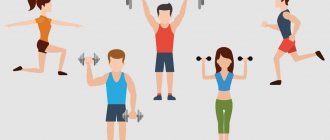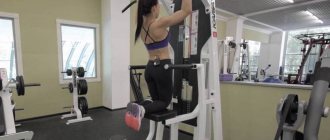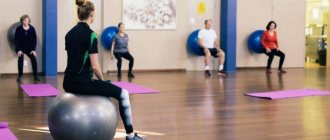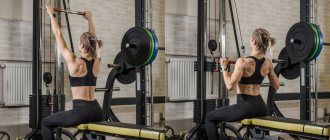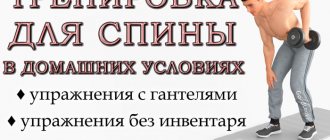The structure of the latissimus muscles
But first, a short excursion into the anatomy and functions of the latissimus muscles. The latissimus muscles themselves look like this.
Latissimus dorsi muscles
As you can see, part of the latissimus muscles are located under a layer of trapezius muscles. And it becomes obvious that the coveted cone-shaped figure, the torso, is formed largely thanks to the latissimus muscles. So their development is not only a matter of strength and muscle mass, but also of body aesthetics.
Pay attention to the following - the broadest muscles, with their wide ends, are attached to the fascia and tendons adjacent to the spine. If suddenly you have some problems with your spine, vertebral instability, osteochondrosis, etc., there is a risk that uneven contraction of the lats will lead to displacement of the vertebrae relative to each other. To reduce this risk of injury, be sure to engage your spinal erector muscles (longus dorsi, erector spinae) when performing any and all lat exercises. Even while doing pull-ups! This is part of proper exercise technique.
Functions of the latissimus dorsi muscles
The main functions of the lats are: moving the arm back, lowering the arm from top to bottom. Therefore, the best exercises will be those in which we do these movements.
Shoulder supination
A very important feature of the attachment of the latissimus muscles to the humerus is the following. The attachment occurs closer to the front of the bone. Therefore, when the lat muscles become tense or shortened due to training, the humerus rotates inward. This is called shoulder supination. And this is another function of the lats.
This feature must be taken into account in training. A constantly supinated humerus due to intense training can lead to injuries to the shoulder joints. This is why it is so important to practice stretching the latissimus muscles. Especially if you are actively training in bench press and deltoid muscle development. Below is one useful exercise for stretching the latissimus muscles. I also recommend paying attention to VPN exercises such as L-extensions.
Martial arts
Another important aspect regarding lat development is its connection to striking martial arts. The fact is that the speed of a punch in boxing directly depends on the development of the boxer’s latissimus muscles. You might think the coach is out of his mind! After all, everyone has long known that in order to develop the speed of a strike, you need to do a lot of push-ups and dumbbell kicks! However, if you delve a little deeper into physiology, it becomes obvious that I am right, and what everyone knows is not entirely true. To make a really fast punch, the muscles that move the arm forward (pectorals, triceps, deltoids) must contract as strongly and quickly as possible. However, if the latissimus muscles are not developed enough, no fast movements will be possible. Because they will be slowed down by a protective reflex that protects your shoulder joints from destruction.
The powerful development of the latissimus muscles (and biceps) ensures effective braking of the arm upon impact at the end of the movement, so this reflex weakens. And the blow eventually becomes much faster and stronger. Therefore, if you are involved in boxing and other striking martial arts, do not forget to pay attention to exercises such as pull-ups, dumbbell rows and others that develop the biceps and lats. My words are confirmed by observing high-class boxers. Notice how developed their biceps and lats are. Often much stronger than the triceps and chest muscles!
Now let's move on to exercises for the latissimus muscles. According to the modern classification, these include vertical rods and horizontal rods. Vertical rows are all exercises that involve pulling a load from above (or using your arms to pull your body up). That is, the direction of the load is parallel to the body. And horizontal rows are exercises in which you need to pull a load towards you using your arms in a backward direction. The direction of the load is perpendicular to the body. Here are the best lat exercises.
Warm-up complexes for stretching the back
Let's look at the main groups of movements and rules on how to stretch your back correctly.
Movement group No. 1: warm-up movements
The work in the warm-up is the most important, but at the same time its main task is not to stretch the muscles, but to prepare them for the upcoming loads. The best option for this would be to tilt the body.
How to do them correctly.
- Place your feet shoulder-width apart.
- Make a slight arch in your back or at least keep it straight.
- Relax your neck muscles.
- Slowly lean forward all the way and lean back from this position.
Everything is just like in physical education. The pace is set to be as comfortable as possible, at which you can achieve the greatest amplitude. Legs must be fixed; bending them is prohibited.
For the muscles of the upper back, you can use a similar exercise called “neck bends.”
The second exercise - the mill - is even simpler, we discussed it above. It is performed at a moderate pace, approximately 1-2 minutes. The speed increases to the maximum possible (while maintaining balance and arching in the back), and you need to touch the opposite leg with your hand.
Movement group No. 2: jerking movements
Exercises aimed at reducing the risk of injury require stricter adherence to technique. For those who have just decided to start doing serious stretching, an exercise familiar to everyone from school physical education lessons is suitable: you need to reach the tips of your toes with your fingers. Another similar exercise in which you need to reach your heels through your back is also very effective. The detailed technique for performing these exercises looks like this:
- Feet shoulder width apart.
- Slight arch in the back.
- Relaxed neck.
- Bend slightly, keeping your legs straight.
- Using jerking movements (not sharp), try to reach the floor or toes with your fingers.
There is also a similar algorithm, only through the back, here the legs can be bent. The back bend can also be performed while kneeling if it is difficult for you to do it at full height (this option was discussed above).
If the exercise seems too easy, try using your palms instead of your fingers, and then, as you develop skill, using your elbows. The main condition is not to bend your knees.
© undrey — stock.adobe.com
Movement group #3: static stretches
Classic exercises for stretching the back are static. They imply maximum load and, accordingly, an increase in the amplitude of work of ligaments, muscles and joints.
Classic exercise - reach the floor with your elbows:
- Feet shoulder width apart.
- Lack of rounded lower back.
- Completely relaxed neck, shoulders and lower back.
- Slowly stretch, trying to touch your elbows to the floor.
- Fix at the lowest point.
A simpler “sitting” exercise:
- Sit down, stretch your legs in front of you, spreading them wide to the sides.
- Relax your back and neck muscles.
- Slowly stretch first to your left leg, fixating at the peak point for 10-20 seconds.
© fizkes — stock.adobe.com
- Then return to the starting position.
- Stretch towards your right leg, similarly fixing yourself at the peak point.
- Return to starting position.
- Stretch straight forward with the same fixation.
© undrey — stock.adobe.com
Hanging on the horizontal bar
A separate exercise is hanging on the horizontal bar. It would seem that everything is very simple - hang, jump, ready. But at the same time, not only the back is stretched, but also the spine - which is important to consider when entering and exiting the apparatus:
- Grip selection. Medium closed grip.
- To approach the projectile, you will need a stool on which you can climb on and off the projectile.
- Grab the horizontal bar, then slowly lower your legs, keeping them suspended.
- Slowly rotate the body at the hip joint clockwise until it stops.
- Then counterclockwise until it stops.
- Perform as long as your wrists have enough strength.
- After finishing, do not jump off under any circumstances, but stand with your feet on the stand and get off.
The ideal option is to work until your wrists completely fail, the break time between approaches is up to 1-2 minutes. If the exercise falls on a training day, this stretching should be done after the main workout.
The most effective exercises for the latissimus muscles
All of the above exercises for the latissimus muscles are divided into two groups: vertical rows and horizontal rows. This is a modern classification of exercises that ensures harmonious development of the body and uniform load on different, opposing muscles. That is, this division of exercises ensures a balance in the strength and muscle mass of the antagonist muscles.
Exercises for the latissimus muscles fall into two categories at the same time. Vertical rows are exercises in which you pull a load from top to bottom along the plane of your body. Horizontal rows are all exercises in which you pull a load towards you from the front across the plane of your body.
For balance in muscle development, it is very important to supplement vertical rows with vertical presses (barbell bench press, standing dumbbell press, standing dumbbell swing), and horizontal rows with horizontal presses (barbell bench press, dumbbell bench press, dumbbell bench press). ). Moreover, the number of approaches and repetitions should be approximately the same for opposite muscles. It is also necessary to strive for at least approximate equality of the weights overcome for opposite movements.
Vertical rods
There are two main movements in this group: pull-ups and vertical rows on machines. This group also includes the pull-over exercise.
Pull-ups
Performed on the horizontal bar. There are many variations of pull-ups: medium grip, wide grip, narrow grip, etc. They all boil down to one thing - you need to use the strength of your arms and latissimus muscles to pull your body up. Wide grip pull-ups:
Pull-ups with a wide grip behind the head. Initial position.
Pull-ups with a wide grip behind the head. Finish.
Medium grip pull-ups:
Pull-ups on the horizontal bar with a medium grip. Start.
Pull-ups on the horizontal bar with a medium grip. Finish.
Close grip pull-ups:
Close grip pull-ups. Initial position.
Close grip pull-ups. Top position.
Performing pull-ups
Hang on the horizontal bar using the appropriate grip. Pull yourself up energetically to chin level or until your eyes are level with the bar. Smoothly lower to the starting position. Repeat without pause the required number of times. Breathing – when pulling up, exhale, when lowering, inhale.
See also: How to learn to do pull-ups on a horizontal bar, How to do pull-ups on a horizontal bar.
Vertical row in the simulator
The vertical row is also a fairly varied exercise. It is performed on a special simulator with an upper block and a handle connected to a cable. The grip can be wide, medium or narrow.
Vertical row with a wide grip to the chest. Initial position.
Vertical row with a wide grip to the chest. Finish.
Performing vertical rows
Set the desired weight on the machine. Install the appropriate handle (wide or narrow). Grasp the handle with the desired grip and sit on the seat. Be sure to rest your knees on the special patella pad so that you are not lifted when performing deadlifts. Vigorously pull the handle toward your upper chest, feeling your lats contract and your shoulder blades close together. Then smoothly return the handle to its original position. Repeat without delay the required number of times. Breathing - when pulling the handle to the chest - exhale, when returning to the starting position - inhale.
Top 4 exercises for the latissimus muscles for the gym and at home
In sports, there are 4 main types of exercises for the latissimus dorsi muscles with dumbbells, barbells and other equipment. Each type has many variations of execution that allow you to change the nature of the load to avoid muscle adaptation. These 4 exercises are fully enough to pump up your lats.
Pull-ups
Ultimate and basic movement for working out the entire group. It is deservedly considered the best exercise for the latissimus dorsi muscles. If you have a weak level of physical fitness, you can perform it with the support of rubber bands (or use lightweight techniques, such as horizontal pull-ups).
Technique:
- Hang from the horizontal bar, holding the handles (or bar) with an overhand grip, slightly wider than shoulder-width apart.
- Begin to pull your body up using your back muscles (at the top point, your arms and shoulders are more involved in the work).
- As soon as your chin crosses the line of the bar, pause and return to the starting position.
- At the lowest point, it is important not to spread your shoulder blades or relax your shoulders, as this can increase the risk of injury.
- Use the grip that allows you to make the movement cleanly and without jerking (with greater development of the biceps, when the triceps becomes a limiting factor, you can master the technique with a reverse grip).
Bent-over row
It can be used in different variations, but the specificity of the exercise is the same. For variety, you can alternate options:
- With rubber band/expander.
- The technique for each exercise will be different, but in all movements it is important to perform the pull using the back , not the arms (the arms only engage when bringing the weight to the body).
- also important to exclude any inertia . Unlike other types of rods, the body must be fixed.
Vertical block thrust
Although this movement is often called a “pull-up replacement,” it is actually incredibly effective. Taking into account the fact that a huge part of athletes (and almost all beginners) cannot do full pull-ups, working with the upper block becomes one of the best among all exercise machines for the latissimus dorsi muscles.
Technique:
- Take the (long) handle with a wide grip and lower yourself onto the seat. The back should be straight, the elbows should be pulled straight to the sides (for the correct position of the shoulder and arm).
- Start pulling the handle towards you without changing the position of your body. The pull is carried out to the upper chest.
- To avoid damaging your nose or face, your head can be pulled back when lowering the handle (no more than 2-3 cm).
- Pause at the bottom and return to the starting position.
Horizontal rods
The peculiarity of these movements for pumping the latissimus dorsi muscles lies in the position of the body. In the lever pull, it is securely fixed and any swinging is excluded - the load will fall on the target muscle. In block deadlifts, on the contrary, it is recommended to swing the body a little, in the range of 10 degrees. This allows for a better stretch of the lats while abducting the handle.
Technique for performing horizontal traction (in a block):
- Sit on the bench and grab the handle so that the cable is taut in the starting position.
- Begin to pull the handle towards your lower abdomen, straightening your shoulders in parallel.
- Pause and return the handle to the starting position (bend your shoulders forward a little to stretch the muscles).
In the exercise, it is important to avoid rocking the body, rounding the back, and pulling with the arms and shoulders.
Exercises for home
In most cases, exercises performed at home for the latissimus dorsi muscles will be a replacement or alternative to movements from the gym:
- Pull-ups - there is nothing to replace them at home; they are performed only with a horizontal bar.
- Horizontal pull-ups – TRX loops, gymnastic rings.
- Vertical traction – in the presence of a horizontal bar and a harness (which will provide tension and the required load).
- Bent-over rows - using dumbbells, a tourniquet, a sandbag, or even a bottle of water or sand (the movement technique does not change).
- Horizontal traction - only with a tourniquet.
These options allow you to completely replace all movements and efficiently work out the lats without losing efficiency.
What about deadlifts?
Separately, it is worth noting the deadlift. This is a technically complex exercise for the latissimus dorsi muscles for men, which is very popular. It is a mistake to use it to load the lats, because the upper back does most of the work. The lats are loaded primarily in the lower part.
Horizontal rods
These are all exercises for the latissimus muscles, performed while bending over or sitting. In these exercises we pull the load towards us across the plane of the body.
Bent-over barbell row
The exercise is performed with a barbell.
Bent-over barbell row. Starting position.
Bent-over barbell row. Finish.
Performing bent-over barbell rows
Set the desired weight on the bar and secure the plates with locks. Bend over and grab the barbell with your hands. Grip width – 75-90 cm depending on your height. The taller you are, the wider you should take it. Take a forward leaning position with your knees slightly bent. The lower back is arched and tense. Pull the barbell vigorously until the bar touches your stomach. Smoothly return the bar to its original position. Perform the desired number of repetitions continuously. Breathing - when pulling the barbell to the stomach - exhale, when lowering the barbell - inhale.
Bent-over dumbbell row
This exercise for the latissimus dorsi is similar to the previous one, but is performed with dumbbells. Moreover, it is important that you will not be able to perform deadlifts with dumbbells weighing half the weight of the barbell from the previous exercise. The weight of each dumbbell will be about 40% of the weight of the barbell. And that's okay.
Bent-over dumbbell rows. Start.
Bent-over dumbbell rows. Finish.
Performing bent over dumbbell rows
Bend over and grab the dumbbells with your hands. Take a correct forward lean position with your legs slightly bent at the knees. The lower back is necessarily arched and tense. Vigorously pull the dumbbells up to waist level. Feel the contraction of the latissimus muscles and squeeze your shoulder blades together. Smoothly return the dumbbells to the starting position. Perform the desired number of repetitions continuously. Breathing - when pulling the dumbbells to the waist - exhale, when lowering the dumbbells - inhale.
See also - exercises with dumbbells at home.
Horizontal row in the simulator
The horizontal row exercise is performed on a special cable machine with a lower block and a handle attached to a flexible cable. The horizontal row is often called rowing, although rowing always involves an element of active leg work and movement of the pelvic area.
Horizontal row on the lat machine
Horizontal row on the lat machine
Performing horizontal rows in the simulator
Set the desired weight on the machine. Sit on the seat, grab the handle, rest your feet on the special bar, straighten your knees and pull the cable. Vigorously pull the handle of the exercise machine towards your stomach. In this case, it is permissible to slightly tilt the torso back. Feel the contraction of the latissimus muscles and squeeze your shoulder blades together. Then smoothly return the handle to its original position, slightly tilting your torso forward and stretching your lats. Breathing - when pulling the handle to the stomach - exhale, when returning to the starting position - inhale.
Horizontal pull-ups also include the pull-up exercise on a low bar (also called Australian pull-ups).
Exercises for the lower back muscles
It is better to leave this group of exercises for the end of the lesson. By strengthening the lumbar muscles, the risk of spinal problems is reduced.
Exercises with weights
Deadlift
This exercise works almost all the muscles in your back and is essential for increasing muscle mass.
- I.p. – standing in front of an empty bar, your legs should be placed slightly narrower than your shoulders, your feet parallel to each other. Keep your back straight and your pelvis pushed back, which creates a natural arch in your lower back. Make sure your back is not round.
- Next, tilt your body slightly forward, pushing your pelvis back. If you did everything correctly, your shoulders will be slightly in front of your shin line. The knees will be slightly bent. The tilt should be made at an angle of 40-45º.
- Squat down to grab the bar with your palms facing you. Make sure your body remains motionless. The shoulders should move along a vertical axis.
- Slowly straighten your legs, and only then straighten your back. When you stand up straight, your shoulder blades should be squeezed together.
- Then start lowering the bar. First, bend your back 40-45º, then your legs.
Do 10-15 repetitions for 3-4 sets.
Deadlift
Before you begin this exercise, make sure you have a good stretch in your lower back and back of your thighs. The main technical points of this exercise are the same as in a regular deadlift.
- I.p. – standing, feet shoulder-width apart, toes under the barbell.
- Do a squat and grab the barbell with the following grip: one hand on top, the other on bottom. The grip should be shoulder width apart.
- The back should be straight. When the bar is above your knees, sharply straighten your legs. Make sure your chest and shoulders are back. Maintain a stable position.
Perform 10-12 repetitions of 3-4 sets.
Sumo deadlift
This deadlift is similar to the classic version, but there are important differences. One of them is that leg stretching is important for this exercise. Also, the feet need to be turned 45º degrees, and the legs should be set quite wide.
- Place your feet wider than your shoulders. Consider your height: the taller you are, the wider your feet should be. The lower back should have a natural arch due to the pelvis moving back. Keep your head straight.
- Do a deep squat with your body slightly bent. Take the bar with a close grip.
- You must lift the barbell using your leg muscles. When your legs are completely straight, straighten your body and squeeze your shoulder blades together.
- There should be no breaks between the work of the legs and lower back; all movements are smooth and measured.
Do 15-20 repetitions for 3-4 sets. Gradually increase the weight.
Forward bends using a barbell
This exercise is the most effective for training the lower back:
- Feet shoulder width apart. Take a barbell with a wide grip, place it on your trapezius and stand straight.
- I.p. – stand up straight, bend your back slightly at the lower back. The lower back muscles should be tense, and your legs should be slightly bent at the knees.
- While inhaling deeply, slowly lean forward while moving your pelvis back.
- When the body is parallel to the floor, take the position.
Perform 10-12 inclines in 3-4 sets.
Latissimus stretch
This exercise is a great stretch for the latissimus dorsi muscles. And you already know why this is needed.
Find some stable, immovable object that is easy to grab onto with your hand. In the video I use a regular ladder on the sports ground.
Grasp a support with your right hand, approximately at waist level, lean forward, take a step back and tilt your entire body back to feel the stretch in the latissimus muscles. To increase the effect, you can place your left hand on your right shoulder. Try to feel the right latissimus muscle from your shoulder to your lower back (yes, it is that long!).
Stay in this position for 10-15 seconds. Next, smoothly exit the exercise and perform it for the left half of the body in the same sequence.
Perform this lat stretch regularly, every day or after training your lats.
Workout Features
Although training the latissimus dorsi muscles is quite simple and requires only an understanding of the basic functions to maximize effectiveness, many athletes neglect the basic rules. This reduces the overall benefit of exercise and slows progression. To pump up the latissimus dorsi muscles, it is recommended to follow a number of basic rules that are related to the specifics and characteristics of the group:
- When performing traction movements, it is necessary to prevent swaying of the body (in exercises, “swinging” of the body is allowed no more than 10 degrees. This contributes to better stretching of the muscle at the peak point).
- When performing exercises for the latissimus dorsi muscles, it is necessary to exclude the use of hands as much as possible (use them only to support the weight).
- The ability to focus on the group being worked on is important. The ability to contract your lats even at rest is the first step towards increasing the effectiveness of your training.
- Movements are performed only in full amplitude (with the exception of some exercises and techniques, for example, static dynamics).
- To pump the latissimus dorsi muscles, you need to work with heavy weights and high load intensity.
The back lends itself well to high-volume training. You can perform at least 10 failure sets of lat exercises, and the average work range per workout can range from 13 to 25 sets without the risk of overtraining.
A set of exercises for the latissimus dorsi muscles
Here are three sets of exercises for training the latissimus muscles: for beginners, for intermediate athletes and for experienced ones. Note that even if the same exercise occurs at different levels, the working weights should be noticeably different. The more training experience, the more weight. Supplement your workouts with one of these complexes 2-3 times a week.
Beginner's complex
Vertical row in the simulator – 3x12-15
Bent-over dumbbell row – 3x12-15
Complex for intermediate level
Medium grip pull-ups – 50 reps (number of sets is not important)
Bent-over barbell row – 4x10-12
A set of exercises for experienced
Wide-grip chest pull-ups – 50 reps (preferably 4-5 sets)
Bent-over barbell row – 4x8-10
Vertical row with narrow grip – 4x10-12
See also - a set of exercises for the gym.
* * *
Try to slightly increase the working weight in exercises at least once a week.
I wish you success in training your lats!
Additional exercises for the latissimus dorsi muscles
Kettlebell lunge row Dumbbell row with one arm bent over row Dumbbell row with one arm Bent over row with dumbbells Bent over row with one end of the barbell Deadlift with a barbell
Tags: martial arts vertical rows horizontal rows lats
TRAINING COURSES
Ready-made sets of exercises for independent training from the author of the site.
